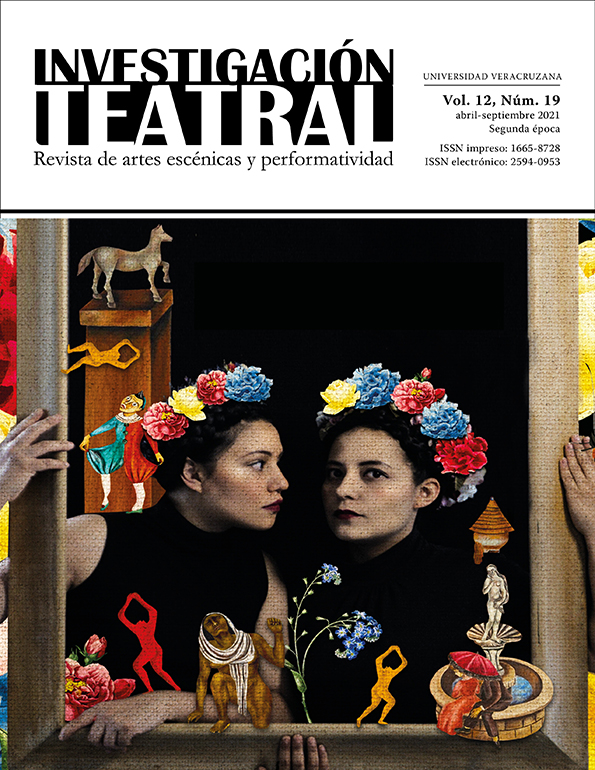Resumen
Este trabajo atañe a la experiencia teatral desde la estética y las ciencias cognitivas. Se defiende la idea de que la actuación estética puede ser entendida como actuación verosímil. Si la experiencia estética posee tres dimensiones –sensorial, conceptual y hedonista–, la verosimilitud en la actuación se lograría en términos de una estrecha y apropiada relación entre ellas. La experiencia estética del espectador sería, pues, una consecuencia de lo que éste percibe, piensa y siente. A su vez, los estudios empíricos permiten establecer criterios objetivos de evaluación para juzgar una actuación como verosímil, tanto por parte del actor como del espectador.
In Defense of the Concept of “Aesthetic Performance” as Truthful Theatrical Performance
This work concerns Aesthetics and Cognitive Science. Furthermore, deals with theatrical issues, defending the idea that an aesthetic performance can be understood as a truthful performance. If the aesthetic experience has three dimensions –sensory, conceptual and hedonistic–, the truthfulness of the performance would be achieved thanks to a close and appropriate relationship between them. The aesthetic experience of the spectator would thus be a consequence of what he/she perceives, thinks and feels. At the same time, empirical studies allow to establish objective criteria of evaluation for judging the truthfulness of a performance, by both the actor and the spectator.
Recibido: 03 de agosto de 2020
Aceptado: 14 de diciembre de 2020
Citas
Aristóteles. Arte y poética. México: Editorial Porrúa, 2013.
Butterworth, Brian. “Evidence From Pauses in Speech”. Psychology, vol. 41, núm.1, 1980, pp. 156-176.
Carroll, Noël. “Theatre and Emotions”. The Oxford handbook of cognitive literary studies. Oxford University Press, 2015, pp. 313-326.
Chawla, Purnima y Robert Krauss. “Gesture and Speech in Spontaneous and Rehearsed Narratives”. Journal of Experimental Psychology, vol. 30, 1994, pp. 580-601.
Ekman, Paul y Wallace Friesen. “Voluntary facial actions generates emotion-specific automatic nervous system”. Society of Psychological research, vol. 27, núm. 4, 1990, pp. 363-384.
Froese, Tom y Ezequiel Di Paolo. “The enactive approach. Theoretical sketches from cell to society”. Pragmatics & Cognition, vol. 19, núm. 1, 2011, pp.1-36.
González, Juan C., Patricia King y Rosa Icela Ojeda. Pensamiento y huella de Francisco Varela en las Ciencias Cognitivas. Madrid: Editorial Académica Española, 2017.
Hamilton, Edith y Huntington Cairns, editores. Plato. The Collected Dialogues. Princeton: Princeton University Press, 1995.
Hecker, Michael y Julie Thompson. “Manifestations of task-induced stress in the acoustic speech signal.” Journal of the Acoustical Society of America, vol. 44, 1968, pp. 993-1001.
Johnston, Daniel. “Stanislavskian Acting as Phenomenology in Practice”. Journal of Dramatic Theory and Criticism, vol. 26, núm 1, 2011, pp. 65-84.
Kircher, Tilo, Michael Brammer, Mathias Bartels y Philip McGuireb. “Pausing for Thought: Engagement of Left Temporal Cortex During Pauses in Speech”. NeuroImage, vol. 21, núm. 1, 2004, pp. 84-90.
Mendoza, Héctor. Actuar o no. México: Arte y escena ediciones, 1999.
Ohala, John. “Production of tone”. Tone: a linguistic survey. Nueva York: Academic Press, vol. 15, núm. 2, 1979, pp. 5-39.
Ohala, John. “The nonlinguistic components of speech”. Speech evaluation in psychiatry. Nueva York: Grune & Stratton, vol. 5, núm.1, 1981, pp. 39-49.
Quinto, Lena, William Thompson, Christian Kroos y Caroline Palmer. “Singing emotionally: a study of pre-production, production, and post-production facial expressions”. Front Psychology, vol. 5, núm. 1, 2014, pp. 262-280.
Robbins, Philip y Murat Aydede. Cambridge handbook on situated cognition. Cambridge: Cambridge University Press, 2009.
Streeter, Lynn. “Pitch Changes During Attempted Deception”. Journal of personality and social psychology, vol. 35, núm.5, 1977, pp. 345-350.
Stanislavski, Konstantin. El trabajo del actor sobre sí mismo. España: Alba Editorial, 2003.
Stanislavski, Konstantin. La construcción del personaje. Madrid: Alianza editorial, 2013.
Stanislavski, Konstantin. Mi vida en el arte. Barcelona: Alba Editorial, 2005.
Tartter, Victor. “Happy Talk: Perceptual and acoustic effects of smiling on speech”. Perception & Psychophysics, vol. 27, núm. 1, 1980, pp. 24-27.
Toriz, Martha. “Las ciencias cognitivas en los estudios del teatro y el performance”. Cátedra de Artes. Vol. 5, núm. 15, 2014, pp. 58-82.
Wilson, Margaret. “Six Views of Embodied Cognition”. Psychonomic Bulletin & Review. University of California, vol. 9, núm. 4, 2002, pp. 625-636.
Williams, Carle y Kenneth Stevens. “Emotions and Speech: Some Acoustical Correlates”. The Journal of the Acoustical Society of America, vol. 52, núm. 4, 1972, pp. 1238-1250.

